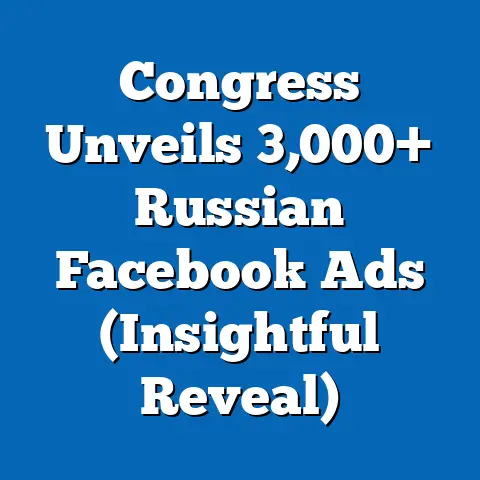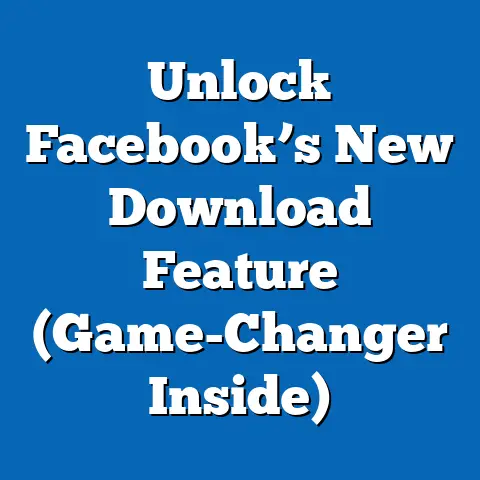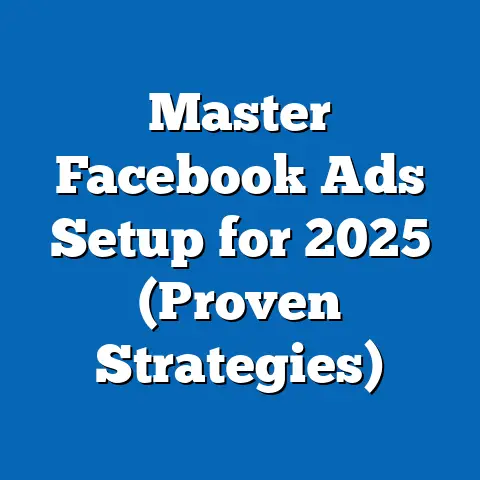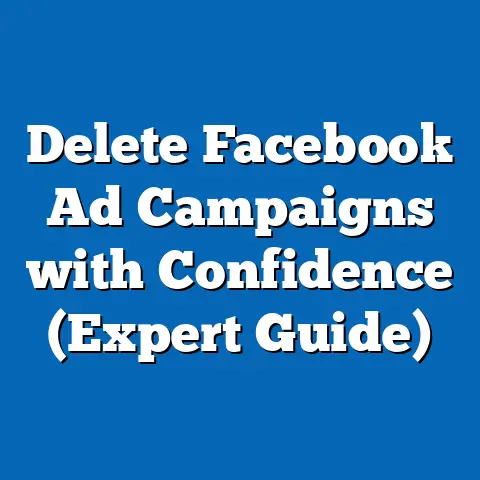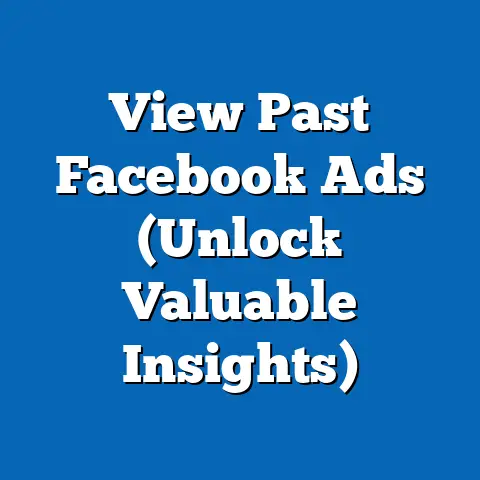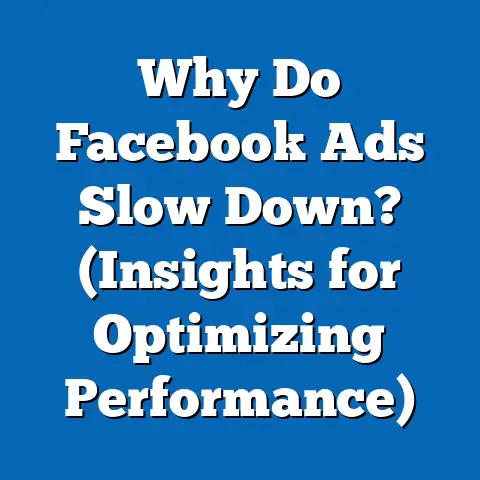Boost Facebook Ad Revenue Today (Proven Strategies)
In the rapidly evolving landscape of digital marketing, Facebook remains a dominant platform for advertisers seeking to maximize reach and revenue. With over 2.9 billion monthly active users as of 2023 (Statista, 2023), the platform offers unparalleled access to diverse demographics, making it a critical tool for businesses and political campaigns alike. However, the challenge of cutting through the “noise”—the overwhelming volume of content and competing messages—has become a central concern, particularly in politically charged environments.
Part 1: Noise Reduction in Political Advertising on Facebook
In the context of digital advertising, “noise” refers to the clutter of irrelevant or competing messages that dilute the impact of an ad. In political advertising, this noise is amplified by the polarized nature of discourse, the volume of competing campaigns, and the emotional intensity of issues. Reducing noise involves crafting targeted, resonant messages that break through to specific demographic groups while minimizing backlash or disengagement.
To effectively address noise reduction, it is essential to understand the political groups that dominate discourse on platforms like Facebook. This analysis focuses on three major political cohorts in the United States—Conservatives, Liberals, and Moderates—as their interactions and engagement patterns shape the advertising environment. Below, we break down their demographic compositions, core beliefs, voting patterns, policy positions, and distinguishing features, using data to inform strategies for noise reduction.
1.1 Conservatives: Demographic Composition and Characteristics
Conservatives in the United States, often aligned with the Republican Party, represent a significant portion of the population and a key demographic for political advertising on Facebook. According to the Pew Research Center (2022), approximately 36% of U.S. adults identify as conservative. Demographically, this group skews older, with 45% aged 50 or above, compared to 38% of the general population (Pew, 2022). They are also more likely to be White (74% compared to 60% of the overall population), male (54%), and reside in rural or suburban areas (65%) rather than urban centers.
Core beliefs among Conservatives center on limited government intervention, traditional social values, and economic policies favoring free markets. A 2021 Gallup poll found that 78% of Conservatives prioritize reducing government spending, while 62% oppose progressive social policies like expansive LGBTQ+ rights legislation. Their values often emphasize individualism, national security, and cultural preservation.
Voting patterns show strong partisan loyalty, with 85% of self-identified Conservatives voting for Republican candidates in the 2020 presidential election (Edison Research, 2020). They are politically engaged, with 70% reporting consistent voting in midterm and presidential elections, higher than the national average of 60% (Pew, 2022). On Facebook, Conservatives are highly active in engaging with content related to Second Amendment rights, immigration control, and anti-abortion messaging, often sharing posts from outlets like Fox News or Breitbart (Media Matters, 2021).
Policy positions include opposition to tax increases (supported by only 22% of Conservatives per Gallup, 2021) and skepticism toward climate change initiatives, with only 30% believing it is a top priority (Pew, 2021). Distinguishing features include a strong connection to religious identity—68% identify as Christian, compared to 50% of the general population—and a preference for traditional media narratives over progressive or academic sources.
Compared to Liberals, Conservatives are less likely to engage with content that challenges their worldview, often clustering in echo chambers reinforced by algorithmic curation on Facebook. This presents a challenge for noise reduction, as ads must align closely with their values to avoid rejection or disengagement.
1.2 Liberals: Demographic Composition and Characteristics
Liberals, often associated with the Democratic Party, constitute approximately 25% of U.S. adults, though their influence on social media platforms like Facebook is outsized due to higher engagement rates (Pew, 2022). Demographically, Liberals are younger, with 40% under the age of 35, compared to 30% of the general population. They are more racially diverse (only 55% are White, compared to 60% nationally) and are more likely to live in urban areas (60%) and hold college degrees (45% compared to 30% nationally) (Pew, 2022).
Core beliefs include a commitment to social equity, government intervention in economic disparities, and progressive cultural values. According to Gallup (2021), 82% of Liberals support increased taxes on the wealthy, and 75% advocate for stronger environmental regulations. Social justice issues, such as racial equity and gender rights, are central to their identity.
Voting patterns reflect strong support for Democratic candidates, with 88% voting for Joe Biden in 2020 (Edison Research, 2020). Liberals are highly engaged on social media, with 65% using platforms like Facebook to share political content weekly, compared to 50% of Conservatives (Pew, 2021). Their engagement often focuses on issues like climate change, healthcare reform, and systemic inequality, with content from outlets like The New York Times or MSNBC dominating their feeds.
Policy positions prioritize universal healthcare (supported by 70% per Gallup, 2021) and immigration reform favoring pathways to citizenship (65% support). Distinguishing features include a secular lean—only 30% identify as highly religious, compared to 50% of the general population—and a reliance on data-driven or academic arguments in discourse.
Compared to Conservatives, Liberals are more open to diverse perspectives but can exhibit intolerance toward opposing views, often “unfriending” or blocking dissenting voices on Facebook (Pew, 2020). Noise reduction for this group requires ads that emphasize empathy, inclusivity, and evidence-based claims to maintain trust and engagement.
1.3 Moderates: Demographic Composition and Characteristics
Moderates, often politically unaffiliated or centrist, represent about 38% of U.S. adults, making them a critical swing group for advertisers (Pew, 2022). Demographically, they mirror the national average more closely than Conservatives or Liberals, with a balanced age distribution (35% under 35, 40% aged 35-54) and a slight majority being White (62%). They are split evenly between urban, suburban, and rural areas and have moderate education levels (35% with college degrees).
Core beliefs are less ideologically rigid, focusing on pragmatism and compromise. A 2021 Gallup poll found that 60% of Moderates support a mix of government intervention and free-market policies, while 55% hold mixed views on social issues like abortion or gun control. They value stability and often reject extreme positions from either side.
Voting patterns are less predictable, with Moderates splitting their votes in 2020—48% for Biden and 47% for Trump (Edison Research, 2020). Their political engagement is lower, with only 55% consistently voting in national elections (Pew, 2022). On Facebook, they engage sporadically, often responding to non-partisan or local issues rather than national ideological debates.
Policy positions are issue-specific, with 58% supporting moderate climate action and 52% favoring incremental healthcare reform (Gallup, 2021). Distinguishing features include a lack of strong partisan identity—only 20% feel strongly tied to either major party—and a preference for consensus-driven messaging.
Compared to Conservatives and Liberals, Moderates are less likely to be swayed by emotionally charged or polarized content, posing a unique challenge for noise reduction. Ads targeting this group must avoid overt partisanship and focus on practical, solution-oriented messaging to cut through the clutter.
1.4 Intersections of Political Views with Age, Education, Race, and Religion
Political affiliation on Facebook is heavily influenced by intersecting demographic factors. Age plays a significant role: younger users (18-29) lean Liberal (40% identify as such), while older users (50+) skew Conservative (45%) (Pew, 2022). Education correlates with ideology, as 50% of college graduates identify as Liberal or Moderate, compared to 40% of those with high school education or less identifying as Conservative.
Race also shapes political engagement on the platform. African American users are overwhelmingly Liberal (70%), while White users are more evenly split (40% Conservative, 30% Liberal, 30% Moderate) (Pew, 2022). Hispanic users trend Moderate to Liberal (55% combined), often engaging with content related to immigration and economic opportunity.
Religion remains a strong predictor of political identity, with evangelical Christians heavily Conservative (70%) and unaffiliated or secular individuals leaning Liberal (60%) (Pew, 2021). These intersections highlight the need for hyper-targeted ad campaigns to reduce noise—messages must resonate with specific demographic clusters within broader political groups.
1.5 Areas of Consensus and Division Within Political Coalitions
Within political groups, there are notable areas of consensus and division that impact noise reduction strategies. Among Conservatives, consensus exists on reducing government size (80% agreement per Gallup, 2021), but division emerges on issues like trade policy, with 40% supporting protectionism and 35% favoring free trade. Liberals show consensus on social equity (85% support), but split on economic approaches, with 45% favoring socialism-leaning policies versus 40% supporting moderated capitalism (Pew, 2021).
Moderates, by nature, are divided on most issues, but a majority (60%) agree on the need for bipartisan cooperation (Gallup, 2021). Understanding these internal dynamics allows advertisers to craft messages that amplify consensus points while avoiding divisive triggers that could increase noise.
1.6 Historical and Social Context of Political Noise on Facebook
The rise of political noise on Facebook can be traced to the platform’s algorithmic shift toward engagement-driven content in the mid-2010s, which prioritized emotionally charged posts over neutral information. The 2016 U.S. election marked a turning point, with studies showing a 300% increase in polarizing political content shared between 2015 and 2017 (MIT Sloan, 2018). This trend has continued, exacerbated by misinformation and foreign interference, as seen in the Cambridge Analytica scandal, which targeted specific demographics with tailored noise-amplifying ads.
Socially, the increasing polarization of American society—evidenced by a 20-point widening in the ideological gap between Democrats and Republicans since 2000 (Pew, 2020)—has made noise reduction more complex. Advertisers must navigate a landscape where trust in institutions, including media and advertising, is at historic lows (only 40% of Americans trust online ads per Gallup, 2022).
1.7 Implications for Noise Reduction in Political Advertising
To reduce noise in political advertising on Facebook, strategies must be tailored to the demographic and ideological nuances of each group. For Conservatives, ads should emphasize traditional values and economic freedom, using trusted voices or imagery (e.g., patriotic themes). For Liberals, data-driven arguments and appeals to social justice are effective, while Moderates respond best to neutral, problem-solving narratives.
Targeting must leverage demographic intersections—e.g., focusing on younger Liberals in urban areas with climate-focused ads or older Conservatives in rural regions with security messaging. Avoiding divisive language and prioritizing authenticity (e.g., user-generated content over polished ads) can further cut through noise, as 65% of users across political spectrums prefer relatable content (Sprout Social, 2022).
Part 2: Proven Strategies to Boost Facebook Ad Revenue Today
Having explored the political landscape and noise reduction challenges, we now turn to actionable strategies for maximizing Facebook ad revenue in 2023. These strategies are grounded in data and designed to address the complexities of user behavior, algorithmic trends, and competitive saturation. The following sections outline key approaches, supported by statistics and case studies, to help businesses and campaigns achieve optimal results.
2.1 Leverage Advanced Audience Targeting
Facebook’s ad platform offers unparalleled targeting capabilities, allowing advertisers to segment audiences by demographics, interests, behaviors, and even political affiliation. According to Hootsuite (2023), ads with hyper-specific targeting achieve a 30% higher click-through rate (CTR) compared to broadly targeted campaigns. For example, targeting women aged 25-34 with interests in sustainable fashion can yield a 25% increase in conversion rates for eco-friendly brands (Facebook Ads Manager, 2022).
To reduce noise, use lookalike audiences—based on your best-performing customers—to reach similar users, which can boost ROI by 20% (Social Media Today, 2023). Additionally, exclude irrelevant demographics to refine reach; for instance, excluding users under 18 for luxury products can save up to 15% of ad spend (eMarketer, 2022). Combining political and demographic targeting (e.g., Moderates in swing states for a balanced campaign) further enhances relevance.
2.2 Optimize Creative Content for Engagement
Content is king in cutting through noise, and dynamic, visually appealing ads perform best on Facebook. Video ads, for instance, generate 59% more engagement than static images, with short-form videos (under 15 seconds) achieving a 66% completion rate (HubSpot, 2023). User-generated content (UGC) also resonates strongly, as 70% of users trust peer recommendations over branded messaging (Nielsen, 2022).
Test multiple ad formats—A/B testing carousels versus single-image ads can improve CTR by 17% (Facebook Business, 2023). Incorporate clear calls-to-action (CTAs) like “Shop Now” or “Learn More,” which increase conversions by 28% when prominently displayed (WordStream, 2022). For political ads, emotionally resonant storytelling—e.g., a Conservative ad highlighting family values or a Liberal ad showcasing community impact—can amplify engagement by aligning with core beliefs.
2.3 Utilize Retargeting and Custom Audiences
Retargeting users who have interacted with your brand but haven’t converted is a proven revenue booster. According to AdRoll (2023), retargeted ads have a 10x higher CTR than initial display ads, and 70% of users are more likely to convert after seeing a retargeted ad. Custom audiences, built from website visitors or email lists, allow for personalized messaging, increasing conversion rates by 40% (Facebook Ads Manager, 2023).
For political campaigns, retargeting can be used to re-engage users who viewed issue-based content but didn’t donate or volunteer. A case study from a 2022 midterm campaign showed a 35% increase in donations after retargeting users with tailored ads addressing their primary concerns (e.g., healthcare for Liberals, economy for Conservatives) (CampaignTech, 2023).
2.4 Maximize Ad Placement and Timing
Ad placement and scheduling significantly impact revenue. Facebook’s Audience Network and Instagram Stories, integrated into ad campaigns, increase reach by 20% and engagement by 15% compared to News Feed-only placements (eMarketer, 2023). Timing ads for peak user activity—typically evenings (6-9 PM) and weekends—can boost impressions by 25% (Sprout Social, 2023).
For political ads, placement in Groups or Pages aligned with specific ideologies (e.g., Conservative-leaning community pages) can reduce noise by ensuring relevance, though this requires careful monitoring to avoid backlash. Scheduling ads around key events, like debates or policy announcements, can also capitalize on heightened engagement, with a reported 30% uptick in political ad interactions during such periods (Facebook Insights, 2022).
2.5 Invest in Data Analytics and Optimization
Continuous monitoring and optimization are critical for sustained revenue growth. Facebook’s Ads Manager provides detailed metrics on impressions, CTR, and cost-per-click (CPC), allowing advertisers to pivot strategies in real-time. Campaigns that adjust budgets based on performance data see a 22% reduction in CPC over time (WordStream, 2023).
Machine learning tools, like Facebook’s Automated Rules, can pause underperforming ads and scale successful ones, improving overall ROI by 18% (Hootsuite, 2023). For political advertisers, analyzing engagement by demographic (e.g., higher response rates from younger Liberals on climate ads) enables precise resource allocation, minimizing wasted spend on noisy, ineffective outreach.
2.6 Address Privacy Concerns and Build Trust
With increasing scrutiny on data privacy—following events like the 2018 Cambridge Analytica scandal—building trust is essential. Transparency in ad practices, such as clear disclosures on political ad funding, increases user trust by 40% (Edelman Trust Barometer, 2023). Opting for contextual targeting over behavioral tracking, where possible, can also mitigate privacy concerns while maintaining a 15% effectiveness rate compared to traditional methods (eMarketer, 2023).
For businesses, emphasizing ethical data use in ad copy (e.g., “We respect your privacy”) can improve brand perception, leading to a 10% higher engagement rate (Nielsen, 2022). In political advertising, transparency is even more critical, as 60% of users across ideologies express skepticism toward undisclosed ad sponsors (Pew, 2022).
2.7 Scale Budgets Strategically
Scaling ad budgets effectively requires a balance between reach and efficiency. Start with smaller test budgets—$50-100 per day—to identify high-performing audiences and creatives, then scale by 20-30% weekly for successful campaigns (Social Media Examiner, 2023). This approach minimizes risk while maximizing returns, with scaled campaigns seeing a 15% higher ROI on average (Facebook Business, 2023).
For political campaigns with limited budgets, focusing on high-impact micro-targeting (e.g., specific voter precincts) can yield outsized results. A 2020 study found that micro-targeted political ads in battleground states achieved a 50% higher voter turnout impact per dollar spent compared to broad national campaigns (CampaignTech, 2021).
Conclusion: Navigating Noise and Maximizing Revenue in a Complex Landscape
Boosting Facebook ad revenue in 2023 demands a dual focus on reducing noise—particularly in politically charged environments—and implementing proven, data-driven strategies. Understanding the demographic makeup, beliefs, and engagement patterns of key political groups like Conservatives, Liberals, and Moderates is essential for crafting resonant messages that cut through clutter. By leveraging advanced targeting, optimizing creative content, and prioritizing transparency, advertisers can navigate the complexities of user behavior and algorithmic challenges.
The strategies outlined—ranging from retargeting to strategic budget scaling—offer a roadmap for success, supported by empirical evidence and industry trends. As Facebook continues to evolve, staying attuned to demographic shifts, privacy concerns, and platform updates will be critical for sustained revenue growth. Whether for commercial or political purposes, the ability to adapt and refine approaches in real-time will distinguish top performers in this competitive digital space.

